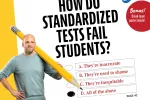Cover Story: Signs of Change
Students call on the nation to make schools safe spaces for teaching and learning.
Funding Failures
Lawmakers refuse to solve school funding problems. We ask three math teachers to provide solutions.
The Journey
Two early-career educators talk about the experiences and the educators who helped to shape their practices.
Professional Development
A roundup of some of NEA’s best affiliate work in PD.
Design Thinking
The mindset that turns students into innovative problem solvers.
Professional Development Gets Flipped
How flipped classrooms helped to change learning for educators.
Climate Change for the Non-Believers
Increasingly, it’s linked to identity. Tips to keep in mind.
Racist Testing
From grade school to college, students of color have suffered the effects of Biased testing.
First and Foremost
Janus v. AFSCME; March For Our Lives in photos; teacher burnout; and NEA partners with Girl Scouts of the USA.
Teaching and Learning
- Seven Simple Steps for a Digital Detox
- How to Build a Creative Classroom Culture
- Preparing for the End of the School Year
Cure Spring Fever By Going Outside
Lynn Cashel, Fourth-grade teacher, Pennsylvania
To keep students focused when the weather turns nicer, I had my math class make a geometry book by photographing geometric shapes around the school—inside and outside. I also offer my students an extra recess as an incentive. When it is earned, we go outside and play a rousing game of kickball. I pitch for both sides just to be fair. - Be Careful of Too Much Sun Exposure
The link between sun exposure and skin cancer is well known these days. Also known is the fact that reducing sun exposure among children can decrease their risk of developing skin cancer in adulthood. With that in mind, the U.S. Centers for Disease Control more than decade ago developed a few guidelines for schools that are still relevant today. These include establishing school policies that make it easier for students to wear hats and sunscreen, and also advocating for more sun protection, either through natural shade, like trees, or constructed shade, like awnings and pavilions. - Have Students Evaluate the Class
Zee Ann Poerio, Fifth-grade teacher, Pennsylvania
I ask my students for their opinions on the activities and special projects that were assigned during the school year. I ask them if I should ‘use it’ or ‘lose it’ for next year and what they liked or disliked about each project. This helps me to evaluate projects from year to year and to modify and adjust my assignments for the following year. The students love this activity because they know that their opinions count, and I love it because I get valuable feedback!
Issues and Impact
West Virginia educators win; and how long-ago government housing policies continue to harm public schools.
People and Places
How one author turned a family secret into a book; and how a Los Angeles school district is working to lower student absenteeism.
Education Support Professionals
We Meet the Needs of the Whole Student
A Note from the Editor-in-Chief
Protect all students in all public schools.
Lily’s Blackboard
We must support student activists as they take the lead on school safety.
Talkback
Working Hard for the Money
I have been an assistant band director for 28 years. “Moonlighting” (Winter 2018). I feel I make less money now than I ever have, due to 8 years of wage freezes (until 2016) and the overall cost of living. I take on extra work to make ends meet: a local retail store, playing in orchestras, concert bands, etc. Still, I feel like I’m scraping by. Meanwhile, administrators earn 6 to 8 percent raises.
—Charles Bradley II
I’ve had a second job for over a decade as a taxidermist just to pay the bills. I work 10 – 12 hours every day of my vacations and weekends. I also work 2 – 3 hours most days after school. The only thing not mentioned in the article is how insurance plans are covering less and less. This year I incurred a $6,400 bill for a biopsy that was pre-approved by the insurance company, but because it was sent to an out-of-network lab, they decided not to cover it. Teaching is getting harder and harder. If I didn’t love my students, I would just leave the profession.
—Dale Davis
What’s at Stake
The union allows our voice and concerns to be heard. “With ‘Janus,’ Corporate Interests Launch Another Attack on Workers” (Winter 2018). With the union, teachers are able to lobby for wages, a workable class size, supplies, and so much more. All teachers should want to have a voice at the table. Teachers who are against the union should ask, who will champion educators and lobby for them against corporate interests? I want someone to lobby for me so I can focus on educating our future! Our union lobbies for teachers rights. Is there another body that could do that important work?
—Sandy Geyer







